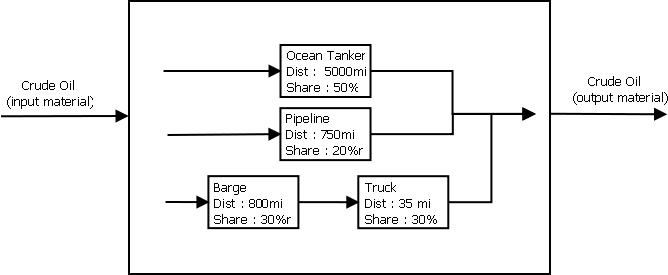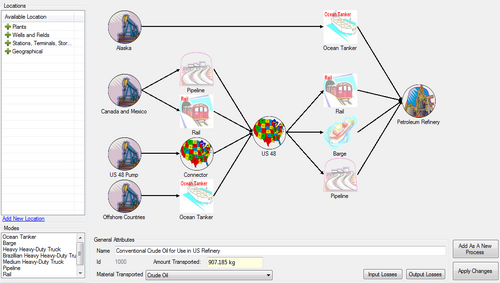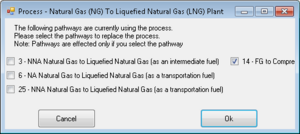Transportation Process
Model
Basically a transportation process describes how a material is transported to one location to another. Typically we have a transportation process between two stationary processes, unless the stationary processes are at the same location.
A transportation process can describe how a material is typically transported from different locations. If the material has been produced overseas, we are going to use an ocean tanker to transport it. If the material is local, we can use ground transportation modes like pipeline or truck.
Inside a transportation process, we define transportation steps. A step consist of a transportation mode, associated to a distance parameter and a share parameter. Above the diagram shows four different steps within the process. The transportation steps can be used in different configurations which might be a sequence of steps, like the barge then the truck, or work in semi-parallel mode like the ocean tanker and the pipeline. The semi-parallel configuration means that the material is coming from different locations, like overseas and Canada, but merge at the same point. For example a refinery can use crude oil coming from many places.
Then we are going to calculate how much energy is needed for each step within the process, and sum them up in order to have the transportation process results. In order to know which materials are used, any steps has a set of fuel shares. In the fuel shares, we might describe which fuels are used to propel the ocean tanker, or what energy is used to run the compressors of the pipeline. The emissions are calculated based on the technologies used by the mode, like a residual oil engine for the ocean tanker, or a electric motor for the pipeline.
There is an analogy which can be made to the stationary process. A stationary process is organized as a tree, where the process is the trunk, branches are the fuels, and leafs are the technologies. In a transportation process, the branches are kind of the technologies ( tanker, pipeline, truck...) and the leafs are the process fuels ( defined by the mode fuel shares ). This is very important because after the processes are broken down into smaller pieces, the same balance algorithm can be used to calculate both of them.
Calculations
Energy Intensity
Ocean Tanker and Barge:
= Energy Consumption in Btu/hphr
= Horse Power
= fuel transported
= process fuel
= constant
= Average Speed (constant)
is calculated as follows:
For the Ocean Tanker :
For the Barge
To calculate ec - energy consumption the following formulas are used:
Ocean Tanker:
Barge:
Truck:
= fuel transported
= process fuel
FuelEconomy = constant
Pipeline:
Given value. There are several fuels which can be used as a process fuel for the Pipeline. However the energy intencity is a function of the type of the fuel:
\begin{itemize}
\item Liquid Fuel
\item Solid Fuel
\item Natural Gas
\item Hydrogen
\end{itemize}
Groups are introduced in greet tatabase in order to sort fuels by types and by any other features.
Rail:
Given Value. Process fuel for Rail is Diesel and ei is constant for any fuel transported.
Editor
To access the Transportation Editor press "Data Editor", "Processes", and then click "Add Transportation Process". Alternatively to modify an existing process click "Modify Existing Process" and select a transportation process.
The first step in creating a new transportation process is to define what Resource will be transported. You can do this via the drop down menu at the bottom of the editor. Directly above this combo box you can define the amount of the Resource that will be transported.
After defining the transported material and amount creating a Transportation Process becomes a simple game of dragging and dropping modes and locations. Modes are means of transportation such as trucks, barge, ocean tanker, etc. They are found in the bottom left of the screen. Locations are area where the material will be transported to and transported from. They are found on the left side of the screen. Basically you use modes to connect different locations.
To add a location or mode to the process, select it an drag and drop it to the empty gray drawing panel. After being dragged hover your mouse over the front (right most side) of an item you dragged to the drawing panel. You will notice a blue rectangle. Click and hold on the front of a location or mode and drag to the back of the of the location or mode you wish to connect it to. While doing this you will notice an arrow following your cursor. This represents the connection. The screenshot on the right shows a finished transportation process.
To remove a connection, mode, or location right click it and select the delete option.
Losses that are included in the efficiency calculation can be added by clicking edit input losses and adding an appropriate loss and output losses for losses not accounted in the efficiency.
After you are done creating/editing the transportation process you can save it. Clicking save will save the new or modified process to the list of processes in memory and any errors that are detected will be displayed. Alternatively if you are editing an existing transportation process and do not wish to overwrite it simply press "Save As A New Process", and it will be saved as a new process.
Other guidelines: In order to be valid, the transportation structure must consist of at least one valid step (an origin, mode, destination set) and only one end destination is valid. In addition, invalid connections are prevented such as connecting two origins to a single mode.
Save as new process
The transportation process offers a "Save as new process" button which will make a copy of the modified process and save it as a new one. Then it will ask you if you want to replace the old one by the new one in the pathways where the old one was used.
The selected pathways will be updated with the new process by clicking ok. This saves time and allow user to change processes in multiple places without having to go to the pathway editor.

















